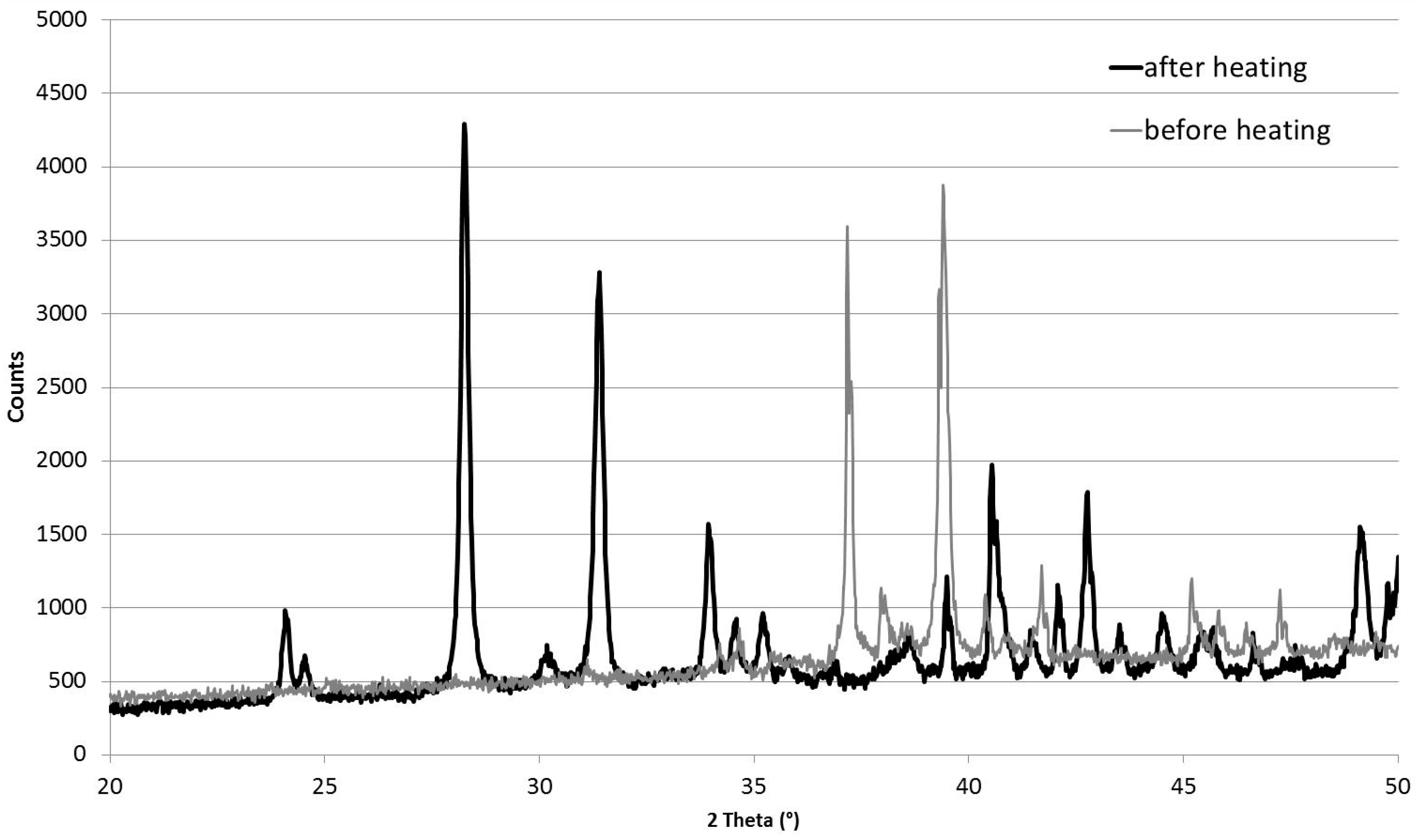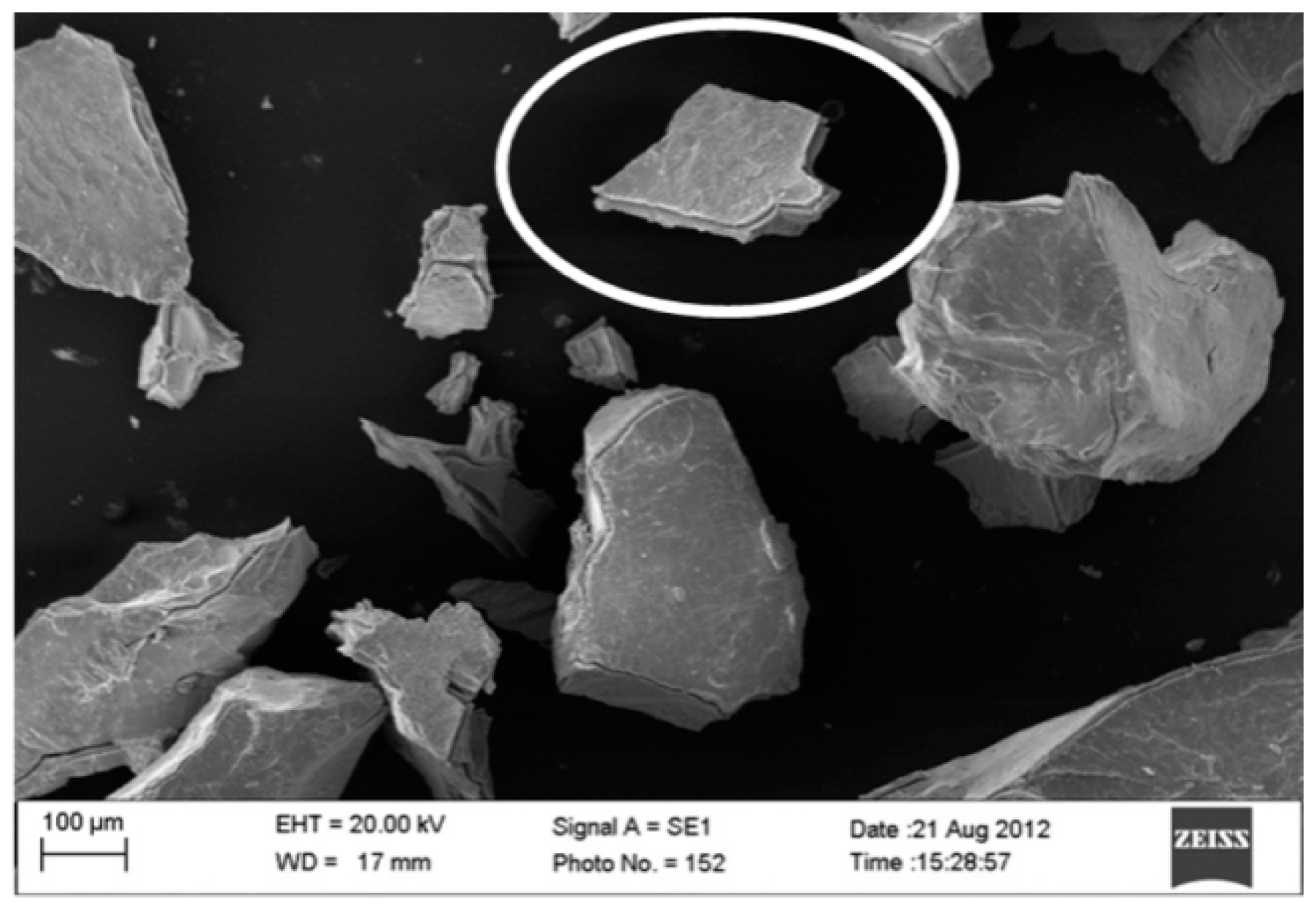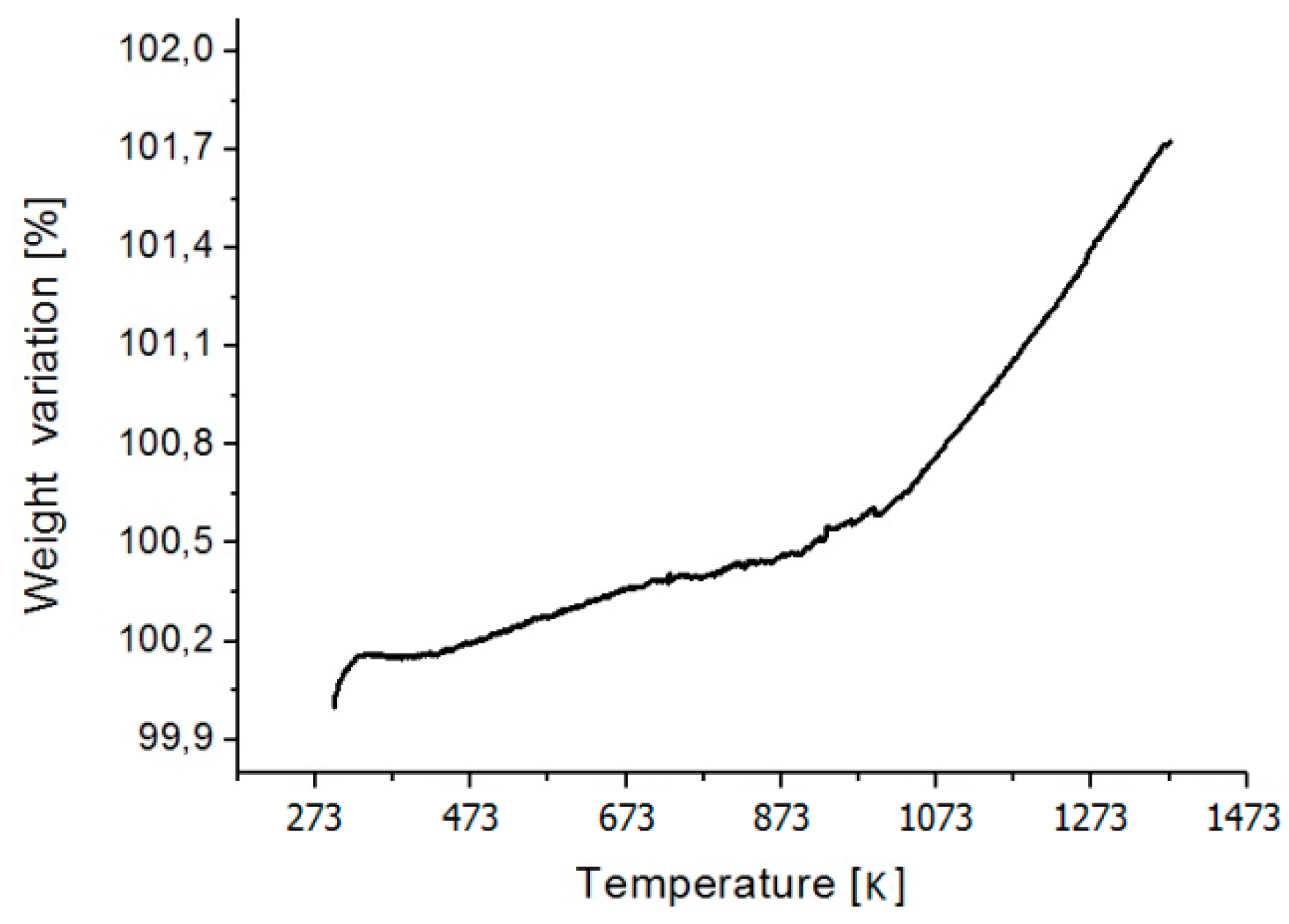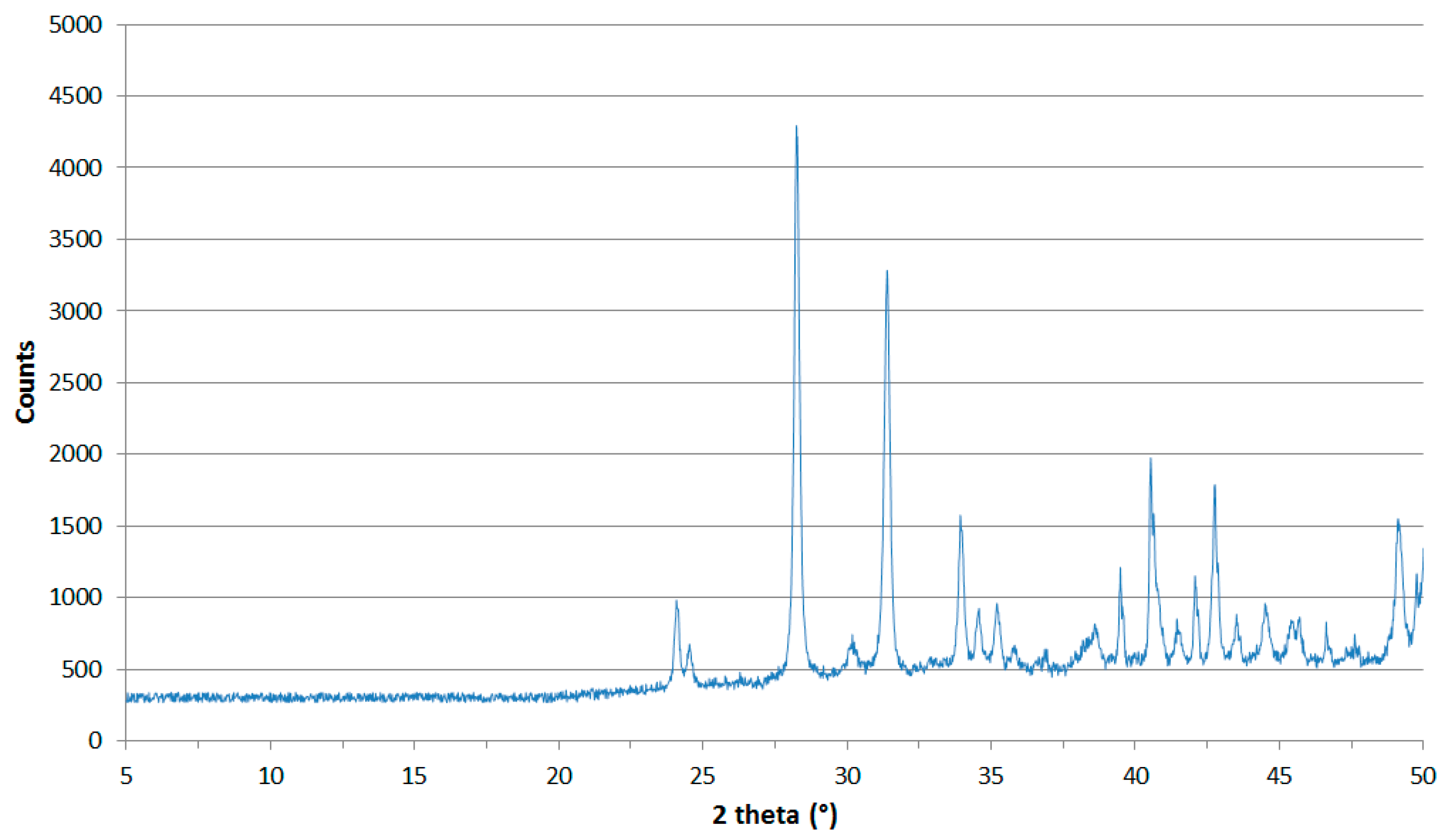Synthesis and Structural Analysis of Copper-Zirconium Oxide
Abstract
:1. Introduction
2. Materials and Methods
3. Results and Discussion
4. Conclusions
Acknowledgments
Author Contributions
Conflicts of Interest
References
- Steiner, S.A.; Baumann, T.F.; Bayer, B.C.; Blume, R.; Worsley, M.A.; Moberlychan, W.J.; Shaw, E.L.; Schoegl, R.; Hart, A.J.; Hofmann, S.; et al. Nanoscale Zirconia as a Nonmetallic Catalyst for Graphitization of Carbon and Growth of Single- and Multiwall Carbon Nanotubes. J. Am. Chem. Soc. 2009, 131, 12144. [Google Scholar] [CrossRef] [PubMed]
- Liu, J.; Meng, X.; Banis, M.N.; Cai, M.; Li, R.; Sun, X. Crystallinity-Controlled Synthesis of Zirconium Oxide Thin Films on Nitrogen-Doped Carbon Nanotubes by Atomic Layer Deposition. J. Phys. Chem. 2012, C116, 14656. [Google Scholar] [CrossRef]
- Piticescu, R.M.; Piticescu, R.R.; Taloi, D.; Badilita, V. Hydrothermal synthesis of ceramic nanomaterials for functional applications. Nanotechnology 2003, 14, 312. [Google Scholar] [CrossRef]
- Chen, Y.Y.; Wei, W.J. Processing and characterization of ultra-thin yttria-stabilized zirconia (YSZ) electrolytic films for SOFC. Solid State Ionics 2006, 177, 351. [Google Scholar] [CrossRef]
- Varez, A.; Garcia-Gonzalez, E.; Jolly, J.; Sanz, J. Structural characterization of Ce1−xZrxO2 (0 ≤ x ≤ 1) samples prepared at 1650 °C by solid state reaction: A combined TEM and XRD study. J. Eur. Ceram. Soc. 2007, 27, 3677. [Google Scholar] [CrossRef]
- Yashima, M.; Hirose, T.; Katano, S.; Suzuki, Y. Structural changes of ZrO2-CeO2 solid solutions around the monoclinic-tetragonal phase boundary. Phys. Rev. B Condens. Matter Mater. Phys. 1995, 51, 8018. [Google Scholar] [CrossRef]
- Fujimori, H.; Yashima, M.; Kakihana, M.; Yoshimura, M. Structural Changes of Scandia-Doped Zirconia Solid Solutions: Rietveld Analysis and Raman Scattering. J. Am. Ceram. Soc. 1998, 81, 2885. [Google Scholar] [CrossRef]
- Torres, F.J.; Amigo, J.M.; Alarcon, J. X-ray powder diffraction study of monoclinic V4+-ZrO2 solid solutions obtained from gels. J. Solid State Chem. 2003, 173, 40. [Google Scholar] [CrossRef]
- Yashima, M.; Tsunekawa, S. Structures and the oxygen deficiency of tetragonal and monoclinic zirconium oxide nanoparticles. Acta Crystallogr. Sect. B Struct. Sci. 2006, 62, 161. [Google Scholar] [CrossRef] [PubMed]
- Bhagwat, M.; Ramaswamy, A.V.; Tyagi, A.K.; Ramaswamy, V. Rietveld Refinement Study of Nanocrystalline Copper Doped Zirconia. Mater. Res. Bull. 2003, 38, 1713. [Google Scholar] [CrossRef]
- Liang, Q.; Wu, X.; Weng, D.; Lu, Z. Selective oxidation of soot over Cu doped ceria/ceria-zirconia catalysts. Catal. Commun. 2008, 9, 202. [Google Scholar] [CrossRef]
- Albisetti, A.F.; Biffi, C.A.; Tuissi, A. Synthesis and structural analysis of Cu10Zr7. J. Alloy. Compd. 2012, 544, 42. [Google Scholar] [CrossRef]
- Biffi, C.A.; Figini, A.; Tuissi, A. Influence of compositional ratio on microstructure and martensitic transformation of CuZr shape memory alloys. Intermetallic 2014, 46C, 4. [Google Scholar] [CrossRef]
- Biffi, C.A.; Albisetti, A.F.; Tuissi, A. CuZr based shape memory alloys: Effect of Cr and Co on the martensitic transformation. Mater. Sci. Forum 2013, 738–739, 167–171. [Google Scholar] [CrossRef]
- Biffi, C.A.; Coduri, M.; Yoshida, H.; Soejima, Y.; Nishida, M.; Tuissi, A. The effect of thermal cycling on the martensitic transformation in equiatomic CuZr shape memory alloy. J. Alloy. Compd. 2015, 653, 591. [Google Scholar] [CrossRef]
- Topas Academic v.4.0 Software Provided by Alan Coehlo. Available online: http://www.topas-academic.net (accessed on 17 August 2016).
- Hill, R.J.; Cranswick, L.M.D. International Union of Crystallography. Commission on Powder Diffraction. Rietveld refinement round robin. II. Analysis of monoclinic ZrO2. J. Appl. Cryst. 1994, 27, 802. [Google Scholar] [CrossRef]




| Formula | Cu0.11Zr0.89O2 | ZrO2 [17] |
|---|---|---|
| fw (g·mol−1) | 120.18 | - |
| System | Monoclinic | Monoclinic |
| Space Group | P21/c | P21/c |
| a (Å) | 5.1843 (6) | 5.1460 |
| b (Å) | 5.2164 (9) | 5.2116 |
| c (Å) | 5.3734 (9) | 5.3130 |
| Mean error | ±0.0009 | - |
| β (°) | 98.842 (4) | 99.222 |
| V (Å3) | 143.59 (2) | 143.6 |
| Z | 4 | 4 |
| d (g·cm−3) | 4.86 | 5.82 |
| 2θ range (°) | 5–120 | 7–162 |
| Rp | 0.061 | 0.031–0.136 |
| Rwp | 0.082 | 0.039–0.187 |
| RBragg | 4.79 | 2.0–16.1 |
| Atom | X | Y | Z | Occ. |
|---|---|---|---|---|
| Cu | 0.2899 | 0.0428 | 0.2187 | 0.11 |
| Zr | 0.2899 | 0.0428 | 0.2187 | 0.89 |
| O1 | 0.0552 | 0.3123 | 0.3615 | 1 |
| O2 | 0.4078 | 0.7448 | 0.5408 | 1 |
© 2016 by the authors; licensee MDPI, Basel, Switzerland. This article is an open access article distributed under the terms and conditions of the Creative Commons Attribution (CC-BY) license (http://creativecommons.org/licenses/by/4.0/).
Share and Cite
Figini Albisetti, A.; Biffi, C.A.; Tuissi, A. Synthesis and Structural Analysis of Copper-Zirconium Oxide. Metals 2016, 6, 195. https://doi.org/10.3390/met6090195
Figini Albisetti A, Biffi CA, Tuissi A. Synthesis and Structural Analysis of Copper-Zirconium Oxide. Metals. 2016; 6(9):195. https://doi.org/10.3390/met6090195
Chicago/Turabian StyleFigini Albisetti, Alessandro, Carlo Alberto Biffi, and Ausonio Tuissi. 2016. "Synthesis and Structural Analysis of Copper-Zirconium Oxide" Metals 6, no. 9: 195. https://doi.org/10.3390/met6090195






